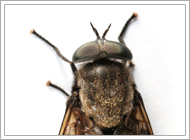Horse Fly

Insects in the order Diptera, family Tabanidae, are commonly called horse flies, and sometimes also forest flies or deer flies. The former, however, can also refer to Hippoboscidae, and the latter refers specifically to the horse-fly genus Chrysops. Often considered pests for the bites that many inflict, they are among the world's largest true flies. They are known to be extremely noisy during flight. They are also important pollinators of flowers, especially in South Africa. Tabanids occur worldwide, being absent only at extreme northern and southern latitudes. Flies of this type are among those known sometimes as gadflies, zimbs or clegs. In Australia, they are known as "march flies"; elsewhere this term refers to the unrelated dipteran family Bibionidae.
There are approximately 3,000 species of horse flies known worldwide, 350 of which are found in North America. At least three subfamilies are recognised:
- Chrysopsinae
- Pangoniinae
- Tabaninae
- the genus Zophina is of uncertain placement, though it has been classified among the Pangoniinae
Two well-known types are the common horse flies, genus Tabanus Linnaeus, 1758 and the deer flies, genus Chrysops Meigen, 1802 also known as banded horse flies because of their coloring. Both these genera give their names to subfamilies. The "Blue Tail Fly" in the eponymous song was probably a tabanid common to the southeastern United States.
All of the above information came from Wikipedia, the free encyclopedia

